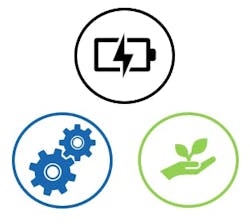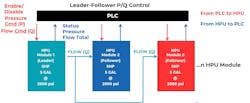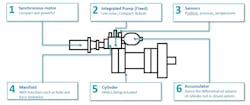Future trends and applications of the electrification of industrial hydraulics
Key highlights
- Modern hydraulics, with electrification and VFD implementation, offers significant energy savings, reduced noise and increased precision and control through PLC integration.
- The adoption of smart hydraulic power units simplifies commissioning, provides pre-programmed logic for hydraulics and offers rich data insights for quicker machine diagnostics.
- Servo-hydraulic actuators combine the high force and shock handling capabilities of hydraulics with the precision and ease of control of electromechanical solutions, all within a compact, self-contained unit.
Hydraulics is no longer the old, loud energy-inefficient technology it once was. In manufacturing, the “future” we once spoke of is here with revolutionary innovation of machines and components positively impacting operations. Currently, our industry focuses on the electrification of hydraulic processes plus a desire for more control, higher energy savings and better analytics. The technology available today focuses on achieving each of these individual factors for peak benefits and output from machines.
There are four main components impacting the industry, including electrification, variable frequency drive (VFD) implementation, smart hydraulic power units (HPUs) and taking advantage of power density. Each component connects to one major goal and trend for electrifying hydraulics: energy savings.
The importance of electrifying hydraulics
Electrifying hydraulics can make things simpler. Electrified solutions help make hydraulic systems easier to understand and integrate into systems.
Energy savings, environmental benefits and technical benefits are key factors to consider when electrifying hydraulic processes. When processes are electrified, you can apply power on demand with the implementation of variable drive systems for energy savings.
Technical benefits include the ability to run at higher efficiencies with precision and repeatability. Due to this electrified connection, operators have more information about their machine to prevent downtime.
Industrial automation and PLC integration
These principles can be applied to an electrical-engineering and industrial-automation perspective, with the biggest impact being on large machinery. Integration of programmable logic controllers (PLCs) allows hydraulics to connect to the control systems via fiel buses for increased precision. System performance is also impacted by the increase in precision alongside the flexibility and quick adaptability to change, such as shifting pressures, flows, position and forces.
Additionally, physical space can be a limited commodity. Integrating electrified hydraulics into machines reduces the space necessary to function and decreases the maintenance needed.
Electrifying hydraulics can have many different functions. This can be incorporated into operations that use ethernet-based communications such as PLCs, connecting to a motor pump group through a variable speed drive. This process can also include installing sensors for data analytics to better understand what’s going on within machines. Additionally, this total integration leverages technology and uses the advantage of hydraulics’ power density to get high forces and power-dense actuation.
VFDs in hydraulic applications
Variable frequency drives (VFDs) are used across industrial automation to vary the speed and torque of ac motors. This includes varying the frequency—the ac signal going to motor—and the voltage, allowing for the control of the output speed of the shaft to a pump that is being controlled. This technology is compatible with all medium-range voltages, from 120 Vac to 690 Vac, or even as small as 100 W to 100 MW. For VFDs to work, the constant voltage and frequency is rectified, converting the ac signal to dc in order to make it variable. Since the dc signal is constant, it is then re-inverted in order to control the output voltage and output frequency. This signal is then reconstructed as a pulse-width-modulated sinusoid that helps control motor speed.
In hydraulic applications, VFDs can have many purposes, notably noise reduction since the speed of the motor is slowed down, even when idle.
Energy consumption is also reduced by the slowing down of pumps when it is in idle, and it is no longer being wasted and released as heat. A reduced need for maintenance also comes into play with the decreased spinning of the pumps increasing the lifespan of the components.
Due to the increase in speed and output flow of hydraulic machines, smaller pumps and motors can be utilized to hit the same power requirements with a VFD. This decreases the size of hydraulics in machines as well as the amount of coolant required to operate. Another benefit of using VFDs is the extra dimension of control where the speed of the motor is directly corresponding to flow which can also control pressure.
Energy savings with variable speed
There are four key levels of energy savings through changes in components to VFDs. The first, lowest savings level is a constant pressure control system. This is the most energy consuming level due to the output flow from constant pump plus the constant electric motor.
Going a step further and adding a variable pump, the second level of energy savings with these machines is in the combination of a variable pump plus a constant electric motor. Variable pumps will reduce the amount of flow by compensating for the lower demand, creating energy savings despite the motor constantly spinning at full speed.
The third highest level of energy savings features a variable pump and a variable drive. The resulting reduced flow and reduced speed saves even more energy. The best, most efficient scenario for energy savings includes this same setup, plus a pump that is slowed down to give flow only when necessary.
Additionally, VFDs can be applied in different scenarios and should be identified after assessing a machine's duty cycle. When applied in hydraulic systems, VFDs excel during intermittent, idle cycles, improving overall energy savings and noise reduction. The best applications for VFDs in hydraulics include machine tools, metallurgy, die casting, wood/paper, presses and plastic machines.
Smart hydraulic power units (HPU)
Power units include a motor tied to a pump, hoses that connect to manifold to give extra functionality and a reservoir that holds oil. Overall, an HPU's key function is to provide pressure and flow to an actuator—a cylinder or a hydraulic motor. This requires an electrical enclosure to interface and control the motor pump grid, valves and data.
Compared to a basic power unit that functions at full speed, a smart power unit has a variable speed via VFDs, giving infinite adjustability and speed. Smart HPUs also provide this interface to easily commission and use the power unit. Additionally, smart HPUs have pre-programmed logic specific to hydraulics in machines, making it one less thing to program in a PLC. If you have these functions applied, power/reactive power (P/Q) commands will do all closed-loop control on demand and manage the health of the power unit (Figure 1).
Lastly, smart HPUs are data-rich from the sensors that reveal a lot about different parts of a machine. From these types of insights, you can diagnose a machine's issue much more quickly with maintenance. In order to modularize hydraulic requirements, electrical power needs to be equivalent to how much current the VFD can emit. Due to this, it's essential to ensure that the motor that the drive is supplying is not going to be limiting the overall output, making VFDs very important in this process.
Taking advantage of power density in hydraulics
Starting with the basics of Pascal’s Law, if a small force is applied over a small area, the entire fluid is able to take on the same pressure across the fluid. Therefore, because pressure is constant to the fluid, the resulting force is much greater than our original force, which can be used in so many applications.
In hydraulics, physics can be used as an advantage for handling shock to loads, requiring minimal compressibility and exhibiting high power density. Hydraulics experience minimally compressible, around .05% per 1,000 psi. In comparison, pneumatics’ air is very compressible, making it tough to gain control or stability when fluid is compressible, similar to how an accordion or spring works. While there is some spring in hydraulics, it's very stiff, making it easy to work with in different applications. Because of this slight spring and compressibility, hydraulics can handle shock to loads when a machine is pressing more gracefully compared to mechanical mechanisms.
Hydraulics is incredibly power-dense, allowing for a large amount of power from just a small amount of oil, allowing for higher forces in a smaller package. All of this plus an input step wave or a command allows for hydraulics to easily stop and start in a stable manner in precise positions and forces.
Different methods of actuation
Pneumatic solutions are very popular in different parts of our industry. Pneumatic cylinders are simple and economical, with cylinders that move in and out quickly.
Electromechanical solutions are usually servo motor-driven, allowing for very fast, precise and simple controllability. Impactful, large forces are possible with this solution.
Finally, conventional hydraulics solutions can reach very high forces and precise positions from minimal compressibility. If a machine is well-maintained, there is a resulting long lifespan due to its self-lubrication, plus hydraulics are cheaper per pound of force compared to other solutions.
Due to recent technological advancements, there are now combinations of these solutions on the market, sometimes referred to as servo-hydraulic actuators (SHAs). These combine the top benefits of the previous three solutions: high force, the ability to handle shock, lubrication, precision, and low cost. SHAs are very simple, have electric power, are easy to control and are very fast due to the self-containment and tight compressed volume.
What’s inside each SHA is what is what makes all the difference. SHAs boast a powerful synchronous motor, a fixed, compact integrated pump, pressure and position sensors, a manifold, the cylinder being actuated and the accumulator that stores the differential oil volume of cylinder rods in close systems (Figure 2). SHAs can also provide different levels of force, which can be manipulated by identifying the level needed and utilizing small or large cylinders. These SHAs look similar to electrical mechanical actuators, but a PLC can communicate position and force to a drive that is extending a cylinder or actuator back and forth. New technologies like SHAs can be applied to operations with continued advancement and education in the industry.
Hydraulics can often be seen as an underdog with the advancement of industrial automation, but the high-quality output and low cost is important to consider when reassessing a facility’s operations in a constantly changing labor market.
About the Author




